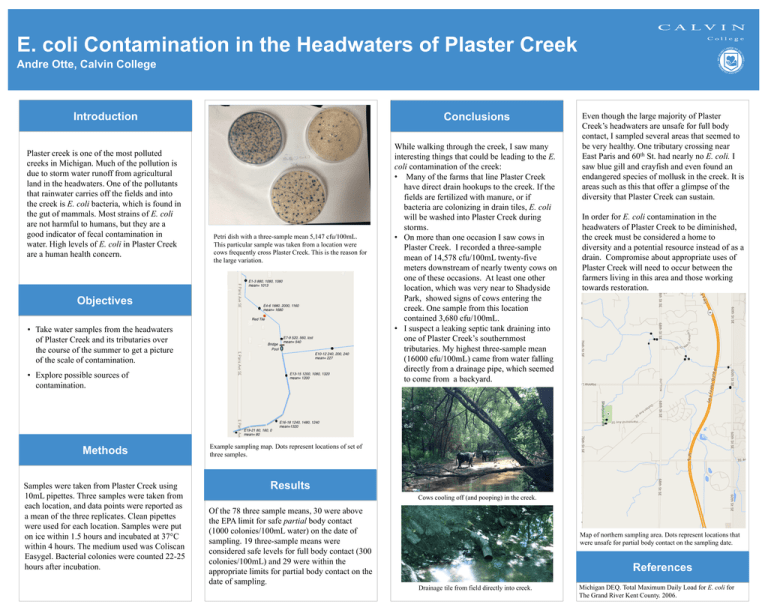E. coli Contamination in the Headwaters of Plaster Creek Introduction Conclusions
advertisement

E. coli Contamination in the Headwaters of Plaster Creek Andre Otte, Calvin College Introduction Plaster creek is one of the most polluted creeks in Michigan. Much of the pollution is due to storm water runoff from agricultural land in the headwaters. One of the pollutants that rainwater carries off the fields and into the creek is E. coli bacteria, which is found in the gut of mammals. Most strains of E. coli are not harmful to humans, but they are a good indicator of fecal contamination in water. High levels of E. coli in Plaster Creek are a human health concern. Conclusions Petri dish with a three-sample mean 5,147 cfu/100mL. This particular sample was taken from a location were cows frequently cross Plaster Creek. This is the reason for the large variation. Objectives • Take water samples from the headwaters of Plaster Creek and its tributaries over the course of the summer to get a picture of the scale of contamination. • Explore possible sources of contamination. Methods Samples were taken from Plaster Creek using 10mL pipettes. Three samples were taken from each location, and data points were reported as a mean of the three replicates. Clean pipettes were used for each location. Samples were put on ice within 1.5 hours and incubated at 37°C within 4 hours. The medium used was Coliscan Easygel. Bacterial colonies were counted 22-25 hours after incubation. While walking through the creek, I saw many interesting things that could be leading to the E. coli contamination of the creek: • Many of the farms that line Plaster Creek have direct drain hookups to the creek. If the fields are fertilized with manure, or if bacteria are colonizing in drain tiles, E. coli will be washed into Plaster Creek during storms. • On more than one occasion I saw cows in Plaster Creek. I recorded a three-sample mean of 14,578 cfu/100mL twenty-five meters downstream of nearly twenty cows on one of these occasions. At least one other location, which was very near to Shadyside Park, showed signs of cows entering the creek. One sample from this location contained 3,680 cfu/100mL. • I suspect a leaking septic tank draining into one of Plaster Creek’s southernmost tributaries. My highest three-sample mean (16000 cfu/100mL) came from water falling directly from a drainage pipe, which seemed to come from a backyard. Even though the large majority of Plaster Creek’s headwaters are unsafe for full body contact, I sampled several areas that seemed to be very healthy. One tributary crossing near East Paris and 60th St. had nearly no E. coli. I saw blue gill and crayfish and even found an endangered species of mollusk in the creek. It is areas such as this that offer a glimpse of the diversity that Plaster Creek can sustain. In order for E. coli contamination in the headwaters of Plaster Creek to be diminished, the creek must be considered a home to diversity and a potential resource instead of as a drain. Compromise about appropriate uses of Plaster Creek will need to occur between the farmers living in this area and those working towards restoration. Example sampling map. Dots represent locations of set of three samples. Results Cows cooling off (and pooping) in the creek. Of the 78 three sample means, 30 were above the EPA limit for safe partial body contact (1000 colonies/100mL water) on the date of sampling. 19 three-sample means were considered safe levels for full body contact (300 colonies/100mL) and 29 were within the appropriate limits for partial body contact on the date of sampling. Map of northern sampling area. Dots represent locations that were unsafe for partial body contact on the sampling date. References Drainage tile from field directly into creek. Michigan DEQ. Total Maximum Daily Load for E. coli for The Grand River Kent County. 2006.



